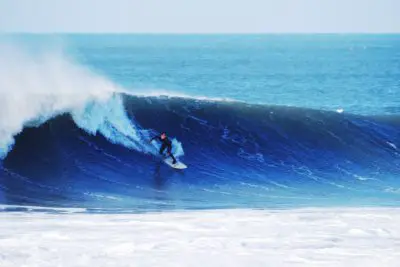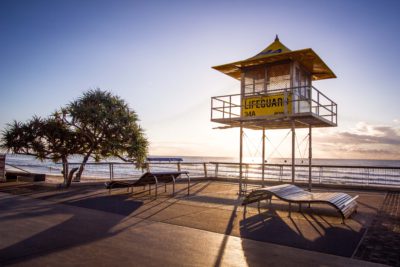Surfing is a great watersport. But sometimes you’re limited when it comes to the UK with the weather being so unpredictable (cold!) even in the summer season. Cornwall is a popular surfers destination and we thought we’d look into why it’s so good. After looking into the details, it’s pretty clear to see that Cornwall is awesome.
Is Cornwall good for surfing? Absolutely! We’ve done a bit of research and listed below the best beaches in Cornwall for surfing:
- Constantine Bay – Top quality waves in North Cornwall.
- Fistral Beach – West facing beach exposed to Atlantic swells
- Porthtowan Beach – Blue Flag award-winning beach
- Godrevy Point – One of the more exposed beaches of the North coast
- Gwithian Beach – Good all-year-round conditions
- Sennan Beach – Cornwall’s most westerly surf hotspot
- Praa Sands – Amazing white sands
- Porthleven Beach – Three miles of sand

Do you want to know a bit more about these surfing beaches? Well, read on. We don’t aim to be experts in surfing lingo, but hopefully, you get our drift. We’ve split up the best beaches by region, so if you ever wanted to go on a surfing tour around Cornwall, we can tell you what you need to know.

Summary: Swell Height & Ability
| Beach | Swell Range (ft) | Suitable For |
|---|---|---|
| Constantine Bay | 2-12 | Pros only |
| Fistral Beach | 2-15 | Beginners and beyond |
| Porthtowan Beach | 2-12 | Pros only |
| Godrevy Point | 1-12 | Beginners and beyond |
| Gwithian Beach | 1-10 | Beginners and beyond |
| Sennen Beach | 2-12 | Beginners and beyond |
| Praa Sands | 2-12 | Beginners and beyond |
| Porthleven Beach | 4-18 | Pros only |
Beaches on the North Side
Constantine Bay
Location: Approximately 3 miles from Padstow.
Sandy or Pebbly? Sandy.
Why? “Swell magnet, beachbreak peaks in the middle of the bay, left off the reef at the south end, right off the point at the north end (quality depends on sand flow from river) and Booby’s to the north has a good but fickle low tide right reef”.
Magic Seaweed
Fun Fact: This was a popular holiday spot for Margaret Thatcher and David Cameron.
Fistral Beach
Location: Newquay.
Sandy or Pebbly? Sandy.
Why? “Very consistent, beachbreak peak, that occasionally gets epic. Mainly rights that get hollow at lower tides. Likes W swell best. Usually a bit bigger than South Fistral”.
Magic Seaweed
Fun Fact: The beach also is the location for a number of surf competitions and festivals throughout the year.

Beaches on the West Side
Porthtowan
Location: Truro
Sandy or Pebbly? Sandy.
Why? “Powerful, hollow beachbreak peaks if the sandbanks are good, plus a bit of wind protection in the southern corner. Consistent, often crowded, rippy and handles some swell, so not really for beginners”.
Magic Seaweed
Fun Fact: This beach has been popular for a long time. In fact, popularity dates back to Victorian times!
Godrevy Point
Location: North-east side of St Ives Bay.
Sandy or Pebbly? Sandy.
Why? “Exposed beachbreak, handles a fair bit of size and works all tides”.
Magic Seaweed
Fun Fact: Seals can often be seen in this region.
Gwithian Beach
Location: Withing St Ives Bay, south of Godrevy Point.
Why? “More sheltered section of beachbreaks south of Godrevy. Great for beginners looking for a bit of space”.
Magic Seaweed
Sandy or Pebbly? Sandy.
Fun Fact: Popular spot for other water sports, such as windsurfing and kite surfing.

Beaches on the South Side
Sennen Beach
Location: Penzance.
Sandy or Pebbly? Sandy.
Why? “Consistent, swell-sucking beachbreak just north of Land’s End is Britain’s most westerly beach. Punchy peaks with barrels when offshore on a medium swell and tide”.
Magic Seaweed
Fun Fact: Sennen Beach is only 2 miles from Land’s End.
Praa Sands
Location: Located between Penzance and Helston.
Sandy or Pebbly? Sandy.
Why? “Classy, fast, tubular beachbreak. Offshore in N winds – dumpy at high, rippy at low. Medium consistency and always busy when on”.
Magic Seaweed
Fun Fact: Pengersick Castle dating back to the 16th century between Germoe and Praa Sands is said to be haunted!
Porthleven
Location: Located around 2 miles from Helston.
Sandy or Pebbly? A bit of both!
Why? “Fast, hollow, crowded reef peak to the west of the harbour. A short right barrel that gets very shallow on the inside and good lefts on certain swell directions. Cornwall’s best reefbreak is always busy when on with a large local crew, pros and media. Dangerous at high and low tide – experts only. Also another hollow right reef in front of the pier popular with lids.”
Magic Seaweed
Fun Fact: You can walk for approximately three miles along the beach to Loe Bar when the tide is out.

Good to Know – Car Parking, Facilities & Lifeguards
| Beach | Car Parking | Toilets | Lifeguard Information |
|---|---|---|---|
| Constantine Bay | Yes | Yes | April: Weekends only May - September: Full cover October: Weekends only |
| Fistral Beach | Yes | Yes | April - October Busy weekends also patrolled |
| Porthtowan Beach | Yes | Yes | April: Weekends only May - September: Full cover October: Weekends only |
| Godrevy Point | Yes (free to National Trust members) | Yes (seasonal) | Mid May - September |
| Gwithian Beach | Yes | Yes | April: Weekends only May - September: Full cover October: Weekends only |
| Sennan Beach | Yes | Yes | April - October |
| Praa Sands | Yes | Yes | April: Weekends only May - September: Full cover October: Weekends only |
| Porthleven Beach | Yes (5 min steep walk from the beach) | Yes | July - September |

What is the Best Time of Year to Surf in Cornwall?
You’d probably think of summer. But actually, with the summer season being the peak time for tourists and beaches getting consumed by crowds of people it can get very busy whether that’s on the waves, on the beach and even getting a car parking spot.
Add in great surf conditions and it’s even busier. So the best time to probably go surfing is the beginning of the Autumn season, ideally September.
The water generally is still warm, it’s definitely quieter and whether you’re a beginner or pro you have more room to practice or simply enjoy the waves.
Most beaches also have Lifeguards on duty in September as well, which is always a bonus.
The Blue Flag
“The iconic Blue Flag is one of the world’s most recognised voluntary eco-labels awarded to beaches, marinas, and sustainable boating tourism operators. In order to qualify for the Blue Flag, a series of stringent environmental, educational, safety, and accessibility criteria must be met and maintained.”
The Blue Flag
For a beach to be awarded the Blue Flag, it must first be assessed on various criteria. The main areas as follows:
- Environmental Information and Education e.g Code of Conduct for the beach.
- Water Quality e.g. any sewage or industrial waste should be absent from the beach.
- Environmental Management e.g. availability of bins and recycling bins.
- Safety & Services e.g. an acceptable number of lifeguards available.
Porthtowan Beach has been awarded the Blue Flag consistently, along with several other beaches in the Cornwall region.
So in Summary…
It goes without saying Cornwall does boast some of the best beaches for surfing in the UK. To add to that, it has stiff competition from other regions, such as Devon, North Wales, and Scotland, but time and time again, Cornwall beaches are still consistently rank high for surfing.
Cornwall also has a good mix of beaches for whatever your ability level. It’s not surprising that it can get quite crowded during the summer months but it’s definitely worth thinking about visiting in the off-peak season.
We hope you enjoyed our article, feel free to check out some of our other content:
